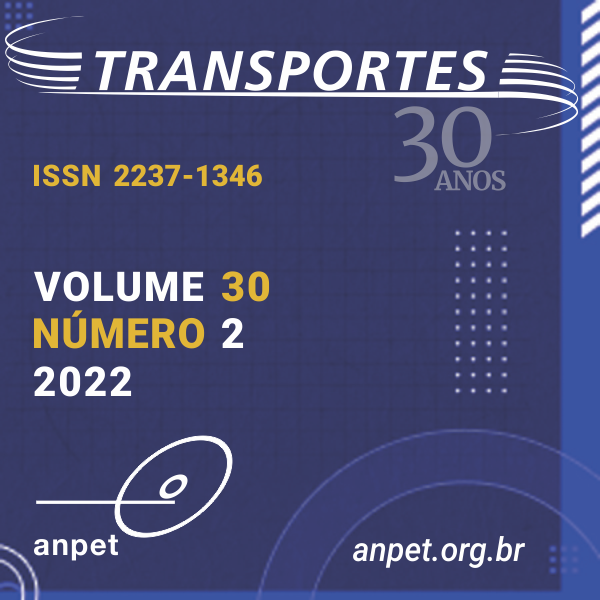Analysis of delivery fee of instant delivery apps and the remuneration of couriers in Brazilian cities
DOI:
https://doi.org/10.14295/transportes.v30i2.2641Keywords:
Urban freight transport, Instant deliveries, Delivery fee, RemunerationAbstract
This paper aims to identify the relationship between the delivery fee of instant deliveries application and the remuneration of couriers in Brazilian cities. Data concerning delivery fees and the distance travelled were obtained from the main delivery applications for eight Brazilian cities: five capitals and three countryside cities. Linear regression was used to identify a relationship between the delivery fee and distance. The results showed a difference in the fixed-rate and the variable delivery fee between the cities. To obtain a basic remuneration, i.e. the minimum wage, the courier must work 44 hours a week, making at least one delivery per hour at 3 km. However, this workday can be strenuous if deliveries are made by non-motorised transport.
Downloads
References
Abílio, L.C. et al. (2020) ‘Condições de trabalho de entregadores via plataforma digital durante a COVID-19’, Revista Jurídica Trabalho e Desenvolvimento Humano, 3, pp. 1–21. DOI: 10.33239/rjtdh.v.74. DOI: https://doi.org/10.33239/rjtdh.v.74
Abílio, L.C. (2020) ‘Uberização: a era do trabalhador just-in-time?’, Estudos Avançados, 34(98), pp. 111–126. DOI: 10.1590/s0103-4014.2020.3498.008. DOI: https://doi.org/10.1590/s0103-4014.2020.3498.008
Abilio, L.C., Grohmann, R. and Weiss, H.C. (2021) ‘Struggles of Delivery Workers in Brazil: Working Conditions and Collective Organization during the Pandemic’, Journal of Labor and Society, pp. 1–19. DOI: 10.1163/24714607-bja10012. DOI: https://doi.org/10.1163/24714607-bja10012
Aliança Bike (2019) Pesquisa de perfil de entregadores ciclistas de aplicativo. Available at: https://aliancabike.org.br/wp-content/uploads/2020/04/relatorio_s2.pdf (Accessed: 9 December 2021).
BBC (2020) ‘Coronavírus: entregadores de aplicativo trabalham mais e ganham menos na pandemia’. Available at: https://www.bbc.com/portuguese/brasil-52564246 (Accessed: 9 December 2021).
Belanche, D. et al. (2021) ‘The role of customers in the gig economy: how perceptions of working conditions and service quality influence the use and recommendation of food delivery services’, Service Business, 15(1), pp. 45–75. DOI: 10.1007/s11628-020-00432-7. DOI: https://doi.org/10.1007/s11628-020-00432-7
Bjørgen, A., Bjerkan, K.Y. and Hjelkrem, O.A. (2021) ‘E-groceries: Sustainable last mile distribution in city planning’, E-groceries, digitalization and sustainability, 87, p. 100805. DOI:10.1016/j.retrec.2019.100805. DOI: https://doi.org/10.1016/j.retrec.2019.100805
Brasil (2020a) Decreto no 10.329, de 28 de abril de 2020: Altera o Decreto no 10.282, de 20 de março de 2020, que regulamenta a Lei no 13.979, de 6 de fevereiro de 2020, para definir os serviços públicos e as atividades essenciais. Available at: http://www.planalto.gov.br/ccivil_03/_ato2019-2022/2020/decreto/D10329.htm#art1 (Accessed: 9 December 2021).
Brasil (2020b) Pesquisa PNAD-COVID19. Available at: https://covid19.ibge.gov.br/pnad-covid/ (Accessed: 9 December 2021).
Buldeo Rai, H., Verlinde, S. and Macharis, C. (2018) ‘Shipping outside the box. Environmental impact and stakeholder analysis of a crowd logistics platform in Belgium’, Journal of Cleaner Production, 202, pp. 806–816. DOI: 10.1016/j.jclepro.2018.08.210. DOI: https://doi.org/10.1016/j.jclepro.2018.08.210
Castro‐Schez, J.J. et al. (2010) ‘A multi‐agent architecture to support B2C e‐Marketplaces: the e‐ZOCO case study’, Internet Research. Edited by L. Martinez‐Lopez and F.J. Martinez‐Lopez, 20(3), pp. 255–275. DOI:10.1108/10662241011050704. DOI: https://doi.org/10.1108/10662241011050704
CNN (2020) ‘Coronavírus: quarentena faz demanda em iFood, Rappi e vendas online dispararem’. Available at: https://www.cnnbrasil.com.br/business/2020/03/20/com-inicio-da-quarentena-demanda-dispara-em-apps-de-entrega-e-compras-online (Accessed: 9 December 2021).
Dablanc, L. et al. (2017) ‘The rise of on-demand “Instant Deliveries” in European cities’, Supply Chain Forum: An International Journal, 18(4), pp. 203–217. DOI:10.1080/16258312.2017.1375375. DOI: https://doi.org/10.1080/16258312.2017.1375375
Guo, C. et al. (2021) ‘Reinforcement learning enabled dynamic bidding strategy for instant delivery trading’, Computers & Industrial Engineering, 160, p. 107596. DOI:https://doi.org/10.1016/j.cie.2021.107596. DOI: https://doi.org/10.1016/j.cie.2021.107596
Huang, W. et al. (2020) ‘Dynamic Scheduling for Urban Instant Delivery with Strict Deadlines’, in ICC 2020 - 2020 IEEE International Conference on Communications (ICC). ICC 2020 - 2020 IEEE International Conference on Communications (ICC), pp. 1–6. DOI:10.1109/ICC40277.2020.9148877. DOI: https://doi.org/10.1109/ICC40277.2020.9148877
iFood (2020) Abrindo a cozinha: cálculo do valor da entrega. Available at: https://institucional.ifood.com.br/abrindo-a-cozinha/calculo-entrega (Accessed: 9 December 2021).
IFood (2020) Estudo Locomotiva. Available at: https://institucional.ifood.com.br/sala-de-imprensa/estudo-locomotiva (Accessed: 9 December 2021).
Kang, P. et al. (2021) ‘Low-carbon pathways for the booming express delivery sector in China’, Nature Communications, 12(1), p. 450. DOI:10.1038/s41467-020-20738-4. DOI: https://doi.org/10.1038/s41467-020-20738-4
Lameiras, M.A.P. et al. (2020) Carta de conjuntura IPEA. 45, pp. 1–27. Available at: https://www.ipea.gov.br/portal/images/stories/PDFs/conjuntura/191212_cc_45_mercado_de_trabalho.pdf (Accessed: 9 December 2021).
Li, C., Mirosa, M. and Bremer, P. (2020) ‘Review of Online Food Delivery Platforms and their Impacts on Sustainability’, Sustainability . DOI:10.3390/su12145528. DOI: https://doi.org/10.32545/encyclopedia202007.0024.v3
de Oliveira, L.K. et al. (2021) Identification of factors to improve the productivity and working conditions of motorcycle couriers in Belo Horizonte, Brazil, Case Studies on Transport Policy, v. 9., n. 4, p. 1737-1745. DOI: 10.1016/j.cstp.2021.09.003 DOI: https://doi.org/10.1016/j.cstp.2021.09.003
Rappi (2020) Aplicativo. Available at: https://www.rappi.com.br (Accessed: 9 December 2021).
Saglietto, L. (2021) ‘Bibliometric analysis of sharing economy logistics and crowd logistics’, International Journal of Crowd Science, 5(1), pp. 31–54. DOI: 10.1108/IJCS-07-2020-0014. DOI: https://doi.org/10.1108/IJCS-07-2020-0014
Seghezzi, A. et al. (2021) ‘“Pony express” crowdsourcing logistics for last-mile delivery in B2C e-commerce: an economic analysis’, International Journal of Logistics Research and Applications, 24(5), pp. 456–472. DOI: 10.1080/13675567.2020.1766428. DOI: https://doi.org/10.1080/13675567.2020.1766428
Tavasszy, L.A. (2020) ‘Predicting the effects of logistics innovations on freight systems: Directions for research’, Transport Policy, 86, pp. A1–A6. DOI: 10.1016/j.tranpol.2019.11.004. DOI: https://doi.org/10.1016/j.tranpol.2019.11.004
Tong, T. et al. (2020) ‘Will dynamic pricing outperform? Theoretical analysis and empirical evidence from O2O on-demand food service market’, International Journal of Production Economics, 219, pp. 375–385. DOI: 10.1016/j.ijpe.2019.07.010. DOI: https://doi.org/10.1016/j.ijpe.2019.07.010
UberEats (2020) A história da Uber. Available at: https://www.uber.com/da-DK/newsroom/history/ (Accessed: 9 December 2021).
Yeo, V.C.S., Goh, S.-K. and Rezaei, S. (2017) ‘Consumer experiences, attitude and behavioral intention toward online food delivery (OFD) services’, Journal of Retailing and Consumer Services, 35, pp. 150–162. DOI: 10.1016/j.jretconser.2016.12.013. DOI: https://doi.org/10.1016/j.jretconser.2016.12.013
Zhang, Y. et al. (2019) ‘Route Prediction for Instant Delivery’, Proceedings of the ACM on Interactive, Mobile, Wearable and Ubiquitous Technologies, 3(3). DOI:10.1145/3351282. DOI: https://doi.org/10.1145/3351282
Downloads
Published
How to Cite
Issue
Section
License
Copyright (c) 2022 Carine Aragão de Mello, Cheyenne Mariana de Oliveira Carneiro, Maria Leonor Alves Maia, Leise Kelli de Oliveira, Gracielle Gonçalves Ferreira de Araújo

This work is licensed under a Creative Commons Attribution 4.0 International License.
Authors who submit papers for publication by TRANSPORTES agree to the following terms:
- The authors retain the copyright and grant Transportes the right of first publication of the manuscript, without any financial charge, and waive any other remuneration for its publication by ANPET.
- Upon publication by Transportes, the manuscript is automatically licensed under the Creative Commons License CC BY 4.0 license. This license permits the work to be shared with proper attribution to the authors and its original publication in this journal.
- Authors are authorized to enter into additional separate contracts for the non-exclusive distribution of the version of the manuscript published in this journal (e.g., publishing in an institutional repository or as a book chapter), with recognition of the initial publication in this journal, provided that such a contract does not imply an endorsement of the content of the manuscript or the new medium by ANPET.
- Authors are permitted and encouraged to publish and distribute their work online (e.g., in institutional repositories or on their personal websites) after the editorial process is complete. As Transportes provides open access to all published issues, authors are encouraged to use links to the DOI of their article in these cases.
- Authors guarantee that they have obtained the necessary authorization from their employers for the transfer of rights under this agreement, if these employers hold any copyright over the manuscript. Additionally, authors assume all responsibility for any copyright infringements by these employers, releasing ANPET and Transportes from any responsibility in this regard.
- Authors assume full responsibility for the content of the manuscript, including the necessary and appropriate authorizations for the disclosure of collected data and obtained results, releasing ANPET and Transportes from any responsibility in this regard.









